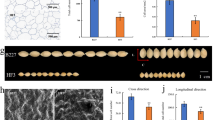Abstract
Amomum tsao-ko (Zingiberaceae) is a commonly used spice and medicinal plant. Morphological variations exist in the fruits of A. tsao-ko. In this study, we compared the phenotypic traits of fruits collected from nine regions in Yunnan Province, China. Based on the mean square values of fruit weight, number of ridges, seed weight, pericarp thickness, and seed diameter, the fruits of A. tsao-ko in Yunnan were grouped into three categories, corresponding to different regions in Yunnan. A principal component analysis revealed that the number of ridges, number of seeds per fruit, and vertical fruit diameter are the most variable parameters. Considering the genetic improvement potential at the regional level, A. tsao-ko in the regions of Gongshan, Tengchong, Jinping, Lushui, and Pingbian is the most efficient for breeding new cultivars, as the plants growing in these regions have a heavier fruit weight, larger fruit diameter, larger transverse diameter, greater number of ridges, greater seed number per fruit, heavier seed weight, moderate pericarp thickness, and larger seed diameter. Based on the selected area, the nested square analysis showed that the fruit vertical diameter, fruit diameter, and the number of seeds per fruit in the region are greater than the regional mean square, and the differences reached an extremely significant level as well. Thus, these three traits can be selected as genetic materials in this region for breeding.




Similar content being viewed by others
References
Cui Q, Wang LT, Liu JZ, Wang HM, Guo N, Gu CB, Fu YJ (2017) Rapid extraction of Amomum tsao-ko essential oil and determination of its chemical composition antioxidant and antimicrobial activities. J Chromatogr B Anal Technol Biomed Life Sci 1061–1062:364–371
Hammer O, Harper D, Ryan P (2001) PAST: paleontological statistics software package for education and data analysis. Palaeontol Electron 4(1):1–9
Lei E, Tian XJ, Yang RP, Su YL, Lu HJ, Liu YH (2013) Study of yield and yield components of Amomun tsas-ko. Southwest China J Agric Sci 06:2493–2496
Li ZQ, Luo L, Dai WH, Huang R, Zhang YQ (1998) Chemical constituents of the essential oil on Amomum tsao-ko from Yunnan Province. Acta Bot Yunnanica 20:119–122
Lim TK (2013) Edible medicinal and non-medicinal plants. Springer, Netherlands, pp 813–817
Ma J, Zhng LX, Peng JM (2008) Chemical composition of Amomum tsao-ko in Xishuangbanna. Chin Tradit Pat Med 30(8):1192–1194
Moon SS, Cho SC, Lee JY (2005) Tsaokoarylone, a cytotoxic diarylheptanoid from Amomum tsao-ko fruits. Bull Korean Chem Soc 26(3):447–450
National Pharmacopoeia Committee (2015) Pharmacopoeia of People’s Republic of China. Chemical Industry Press, Beijing, p 409
Rahman MR, Lou Z, Yu F, Wang P, Wang H (2017) Anti-quorum sensing and anti-biofilm activity of Amomum tsaoko (Amommum tsao-ko Crevost et Lemarie) on foodborne pathogens. Saudi J Biol Sci 24(2):324
The Kunming Institute of Botany (1997) The flora of Yunnan. The Science Publishing Company, Beijing, pp 618–639
Yang Y, Yan RW, Cai XQ, Zheng ZL, Zou GL (2008) Chemical composition and antimicrobial activity of the essential oil of Amomum tsao-ko. J Sci Food Agric 88(12):2111–2116
Yang X, Küenzi P, Plitzko I, Potterat O, Hamburger M (2009a) Bicyclononane aldehydes and anti-proliferative constituents from Amomum tsao-ko. Planta Med 75(05):543–546
Yang YW, Liu XL, Pu CX, Yang JL, Qian ZG (2009b) Study on quantitative multistate character of fruit and seed of Amomun tsao-ko. J Chin Med Mater 32(008):1184–1187
Yang Y, Yang Y, Yan RW, Zou GL (2010) Cytotoxic, apoptotic and antioxidant activity of the essential oil of Amomum tsao-ko. Bioresour Technol 101(11):4205–4211
Yu L, Shirai N, Suzuki H, Hosono T, Nakajima Y, Kajiwara M, Takatori K (2008) Effect of lipid extracted from tsao-ko (Amomum tsao-ko Crevost et Lemaire) on digestive enzyme activity, antioxidant activity, plasma and liver lipids, and blood glucose levels of mice. J Nutr Sci Vitaminol 54(5):378–383
Yu L, Shirai N, Suzuki H, Sugane N, Hosono T, Nakajima Y, Kajiwara M, Takatori K (2010) The effect of methanol extracts of tsao-ko (Amomum tsao-ko Crevost et Lemaire) on digestive enzyme and antioxidant activity in vitro, and plasma lipids and glucose and liver lipids in mice. J Nutr Sci Vitaminol 56(3):171–176
Zhang YH (2013) The constituent research on three medicinal materials from Yunnan. Yunnan University Of traditional Chinese medicine, Kunming
Acknowledgements
This work was supported by the Project of Young and Middle-aged Talent of Yunnan Province (Grant No. 2017HB076) and by National Natural Science Foundation of China (NSFC) (Grant Nos: 31460380, 81560615).
Author information
Authors and Affiliations
Contributions
Yang SC, Zhang W, Lu BY conceived and designed the experiments; Zhang W, Meng HL and Wei X performed the experiments; Yang SC and Yang ZQ analysed the data; Zhang W, Meng HL and Yang ZQ wrote the manuscript.
Corresponding author
Ethics declarations
Conflict of interest
The authors declare they have no conflicts of interest.
Additional information
Publisher's Note
Springer Nature remains neutral with regard to jurisdictional claims in published maps and institutional affiliations.
Rights and permissions
About this article
Cite this article
Wei, Z., Bingyue, L., Hengling, M. et al. Phenotypic diversity analysis of the fruit of Amomum tsao-ko Crevost et Lemarie, an important medicinal plant in Yunnan, China. Genet Resour Crop Evol 66, 1145–1154 (2019). https://doi.org/10.1007/s10722-019-00765-x
Received:
Accepted:
Published:
Issue Date:
DOI: https://doi.org/10.1007/s10722-019-00765-x




